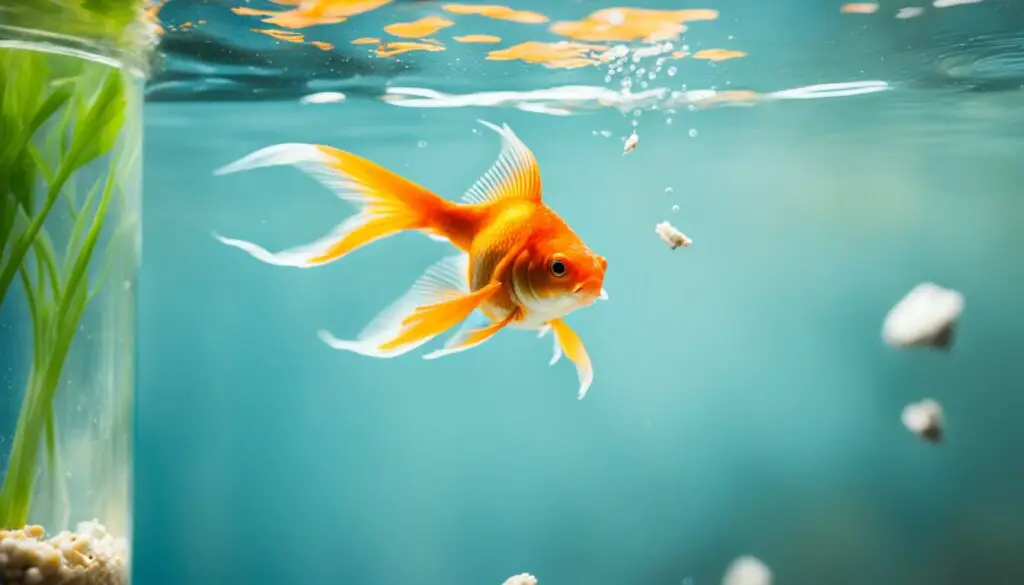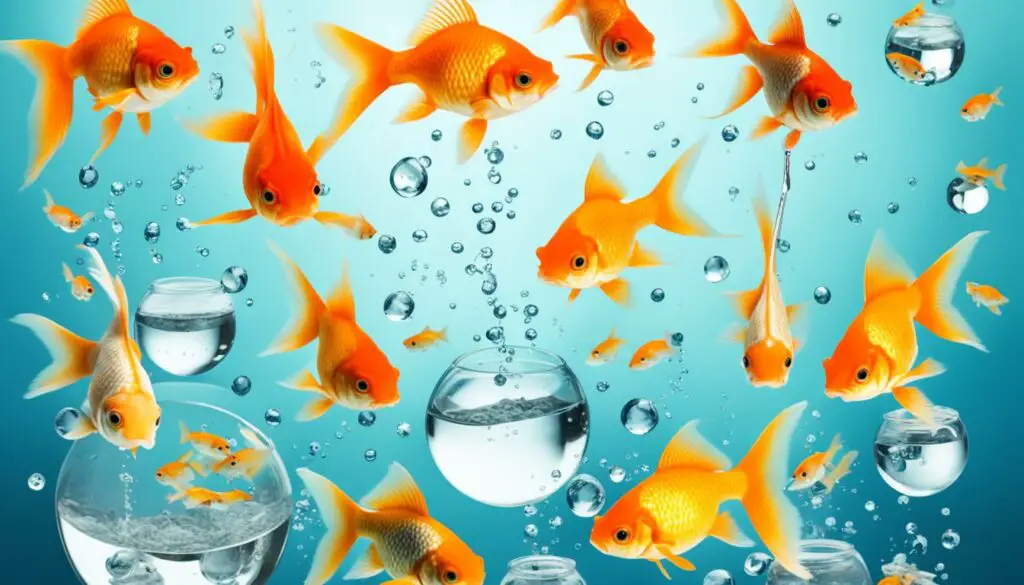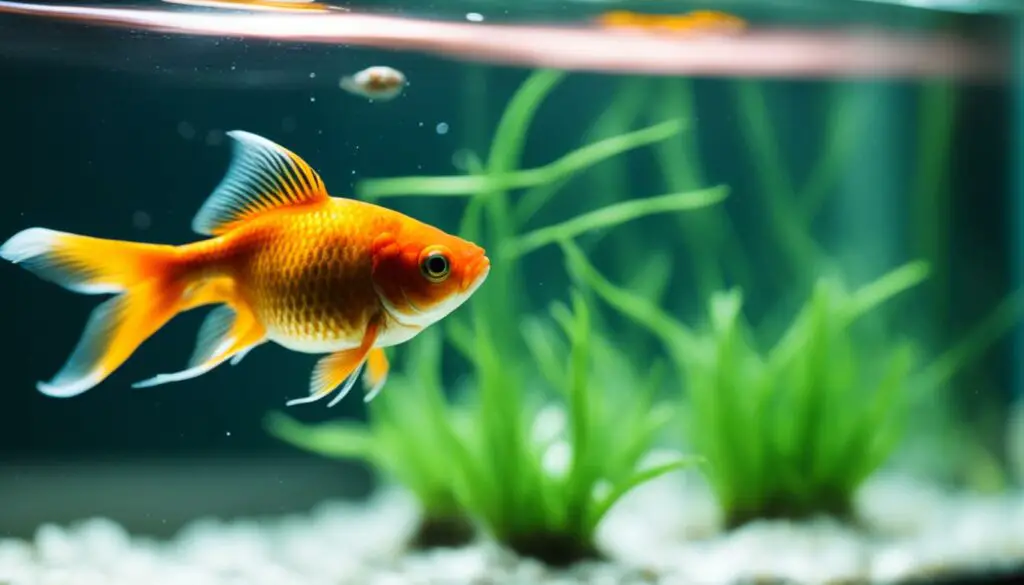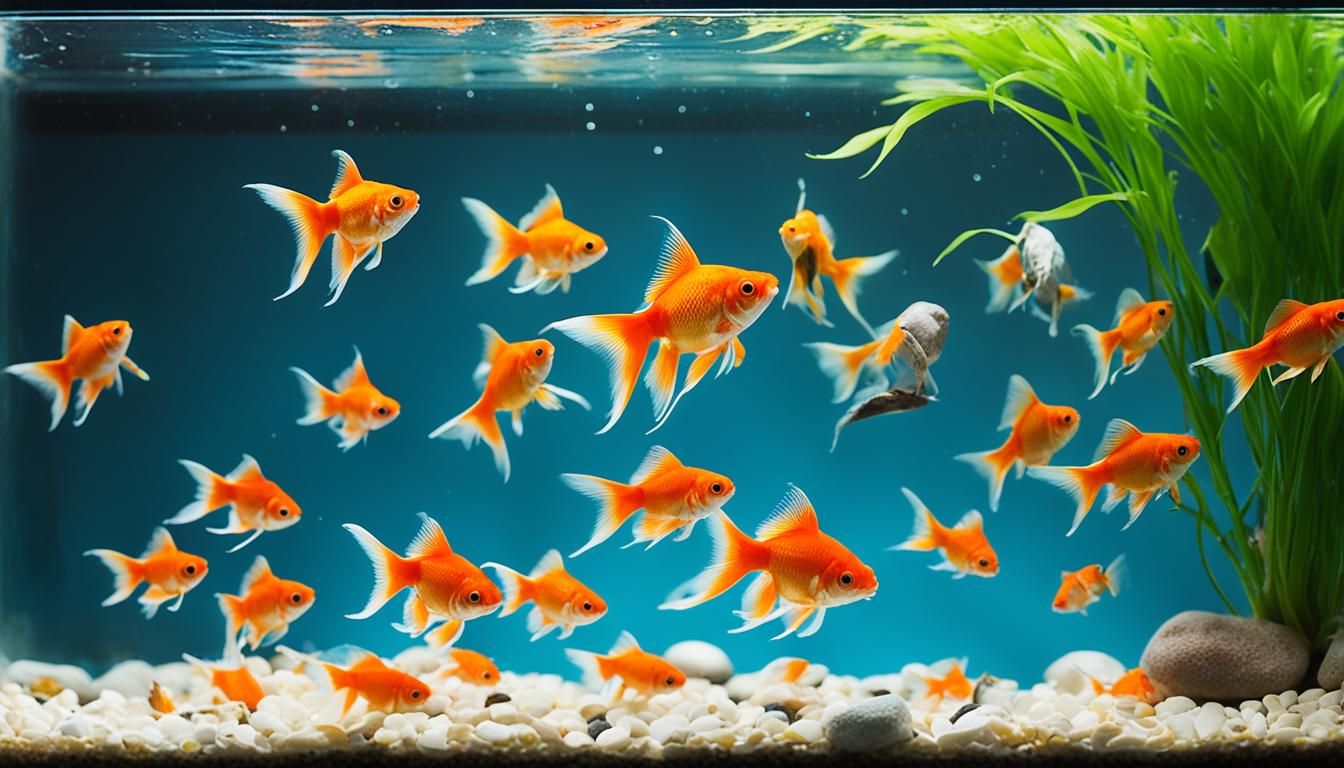Last Updated on 3 months by admin
Welcome to our article on goldfish growth and the common misconception surrounding their tank size. There has been a long-standing belief that goldfish will grow to the size of their tank, leading many fish owners to invest in larger tanks or ponds. However, we are here to debunk this myth and provide you with accurate information regarding goldfish growth and tank requirements.
Goldfish are fascinating creatures that have the ability to self-limit their growth based on the size of their environment. This phenomenon, known as stunting, is a natural mechanism that allows goldfish to adapt to their surroundings. It is not solely dependent on the size of the tank, but rather influenced by various factors such as genetics, nutrition, and water quality.
While goldfish can grow to be large in the right conditions, they are also able to thrive in smaller tanks. In fact, goldfish can even have a longer lifespan when stunted. This is due to the production of growth-inhibiting hormones, such as somatostatin, that regulate their size in smaller environments. Additionally, genetics play a role in determining the size of a goldfish, as some fish are naturally smaller regardless of their environment.
Key Takeaways:
- Goldfish have the ability to self-limit their growth based on the size of their environment.
- Stunting is a natural mechanism that allows goldfish to adapt to their surroundings.
- The size of the tank is not the sole determinant of goldfish growth.
- Growth-inhibiting hormones and genetics also play a role in goldfish size.
- Proper nutrition and water quality are crucial for the overall well-being and healthy growth of goldfish.
Understanding Stunting in Goldfish

Stunting in goldfish can be influenced by both environmental and genetic factors. Goldfish have the remarkable ability to produce growth-inhibiting hormones, such as somatostatin, to regulate their size in smaller environments. These hormones act as natural growth inhibitors, restricting the goldfish’s own growth and allowing them to adapt to their surroundings.
This unique mechanism enables goldfish to remain smaller in tanks or bowls without the need for frequent water changes or larger living spaces. Stunted goldfish can actually have a longer lifespan and be more resilient compared to those that reach their full size. They are often better equipped to cope with suboptimal conditions, such as limited space or irregular feeding.
While environmental factors like tank size can contribute to stunting, it is essential to acknowledge that genetics also play a significant role in determining a goldfish’s potential size. Some goldfish breeds are naturally inclined to be smaller, irrespective of their environment. This genetic predisposition is inherent and independent of the tank or bowl they are kept in.
“Stunting in goldfish is a fascinating adaptation that allows them to thrive in a variety of environments, even ones with limited space. It’s a testament to their resilience and adaptive capabilities.”
Effects of Stunting on Goldfish Lifespan
Contrary to popular belief, stunting does not necessarily diminish a goldfish’s lifespan. In fact, stunted goldfish can live just as long, if not longer, than their counterparts that have reached their full size. This is mainly attributed to their ability to adjust to less ideal conditions and adapt to their surroundings.
Stunted goldfish have been observed to exhibit better disease resistance and survival rates compared to larger goldfish. The reduced metabolic demands resulting from stunted growth may contribute to their increased resilience. While larger goldfish may succumb to stressors more easily, stunted goldfish have a greater capacity to withstand adverse conditions, ultimately leading to a longer lifespan.
Growing Goldfish: Balancing Size and Well-being
When it comes to raising goldfish, it is important to strike a balance between promoting natural growth and ensuring the well-being of the fish. Providing a suitable environment with adequate space, proper filtration, and water quality is essential for the overall health and development of goldfish.
While stunting is a fascinating phenomenon, it is crucial to consider the needs and potential of each individual fish. A well-maintained tank that allows for natural growth and provides ample space for swimming and exercise is ideal for most goldfish. By understanding the factors that influence growth, both genetic and environmental, goldfish owners can make informed decisions to provide the best possible care for their aquatic companions.
| Factors Influencing Goldfish Growth | Description |
|---|---|
| Water Quality | Good water quality is essential for goldfish growth. Poor water conditions can hinder growth and affect overall health. |
| Nutrition | A balanced diet with proper nutrition is crucial for optimal growth. Goldfish require a varied diet that includes high-quality pellet or flake food supplemented with fresh vegetables and occasional treats. |
| Stress Levels | Stress can impact goldfish growth. A calm and stress-free environment promotes healthy growth and overall well-being. |
| Health Status | A goldfish’s overall health, including genetics and any preexisting conditions, can affect growth. Ensuring proper healthcare and disease prevention measures are in place is important. |
Debunking Tank Size Guilt and Profits

Many pet stores and online forums perpetuate the myth that goldfish require large tanks or ponds, resulting in unnecessary guilt and expensive equipment sales. This misinformation leads to the exclusion of potential goldfish owners with smaller incomes or living spaces.
“You need at least a 50-gallon tank for a goldfish to thrive.”
– Pet Store Employee
This common misconception creates a false sense of guilt among goldfish owners who may not have the means to provide such a large enclosure. It often forces them to reconsider owning these beautiful creatures altogether.
Contrary to popular belief, goldfish bowls are not inherently detrimental to their health. While it is true that goldfish require adequate space to swim and grow, the size of the tank alone does not determine their overall well-being.
There have been documented cases of goldfish living long and healthy lives in bowls with proper care and maintenance. As long as the water quality is maintained and the goldfish’s needs are met, they can thrive in smaller environments.
The focus should be on providing the necessary care for goldfish, including good water quality, appropriate feeding habits, and regular monitoring of their health. This ensures their well-being and growth, rather than solely fixating on the size of the tank.
Why the Misinformation Persists
There are several reasons behind the perpetuation of goldfish tank size requirements:
- Inaccurate information provided by misinformed pet store employees.
- Profit-driven motives of pet stores, as larger tanks and equipment lead to increased sales.
- Goldfish bowl slander stemming from a desire to discourage the use of smaller tanks.
It is important for potential goldfish owners to recognize that the well-being of their fish is not solely dependent on the size of their tank. Proper care, regular water changes, and a balanced diet are of greater importance.
Debunking these misconceptions will enable goldfish enthusiasts to provide suitable homes for their pets without unnecessary guilt or financial strain.
Goldfish Size: The Reality vs. Exaggeration
Contrary to common misconceptions, goldfish do not naturally grow to be one foot or larger. The size of a goldfish can vary depending on the breed and genetic factors. Common goldfish typically range from four to six inches in length, with some occasionally reaching eight inches. Fancy goldfish, known for their unique characteristics, can also vary in size but generally remain smaller compared to common goldfish. It is important to understand the natural size range of different goldfish breeds to provide appropriate tank sizes.
Factors Impacting Goldfish Growth

While tank size may not directly influence the growth of goldfish, there are other crucial factors that can affect their growth. Understanding and addressing these factors is essential for promoting healthy growth and maintaining the overall well-being of your goldfish.
1. Water Quality
Water quality is of utmost importance when it comes to goldfish growth. Poor water conditions can hinder their growth and lead to various health issues. It is crucial to maintain clean and well-filtered water in the aquarium. Regular water testing and monitoring of parameters such as ammonia, nitrite, nitrate levels, and pH are necessary to ensure optimal water quality.
2. Nutrition and Diet
A well-balanced and nutritious diet is vital for the growth and development of goldfish. Feeding them high-quality goldfish pellets or flakes that contain essential nutrients and vitamins is recommended. It’s important to provide the right amount of food and avoid overfeeding, as excess food can lead to poor water quality and health problems.
3. Stress Levels
Stress can negatively impact goldfish growth. Factors such as overcrowding, aggressive tankmates, improper handling, or sudden changes in the environment can cause stress in goldfish. Creating a serene and stress-free environment by ensuring appropriate tank size, suitable tankmates, and minimal disturbances can help promote healthy growth.
4. Health Status
The overall health status of your goldfish plays a significant role in their growth. Regular health check-ups and monitoring for any signs of illness or disease are essential. Promptly addressing any health issues and providing appropriate treatment can prevent stunted growth and enable optimal growth.
In conclusion, while tank size may not directly impact goldfish growth, factors such as water quality, nutrition, stress levels, and overall health status are crucial. By creating a favorable environment and addressing these factors, you can promote healthy growth and ensure the well-being of your goldfish.
| Factors | Impact on Goldfish Growth |
|---|---|
| Water Quality | Hinders growth and overall health if poor |
| Nutrition and Diet | Promotes optimal growth when balanced and nutritious |
| Stress Levels | Negatively affects growth, creating a stress-free environment is crucial |
| Health Status | Healthy goldfish are more likely to exhibit optimal growth |
Mechanism of Size Regulation in Goldfish

Goldfish possess the remarkable ability to regulate their size through the production of growth-inhibiting hormones and inhibitory neurotransmitters. These compounds are responsible for influencing the maximum size a goldfish can reach in an enclosed environment, such as a tank. When goldfish are kept in a limited space, the secretion of growth-inhibiting hormones is triggered, leading to a mechanism that restricts their growth and maintains a smaller size.
The production of growth-inhibiting hormones is a natural adaptation that allows goldfish to adapt to their surroundings. When a goldfish is housed in a smaller tank, the buildup of these compounds in the water further contributes to stunted growth. The presence of these hormones in the aquatic environment signals to the goldfish that the available space is limited, resulting in the suppression of their growth potential.
However, it is important to note that the regulation of goldfish size is not solely dependent on tank size. Other factors also play a role in influencing their growth, including water quality and overall health. While a smaller tank can contribute to stunted growth, poor water quality or inadequate nutrition can further hamper their development.
| Factors influencing goldfish growth | Key points |
|---|---|
| Goldfish size regulation | The production of growth-inhibiting hormones and inhibitory neurotransmitters helps regulate the size of goldfish in limited tank environments. |
| Growth-inhibiting hormones | The secretion of growth-inhibiting hormones is triggered by limited tank space, signaling the goldfish to restrict their growth. |
| Water quality | Poor water conditions can hinder goldfish growth, irrespective of tank size. High-quality water is crucial for optimal growth. |
| Overall health | The physical health and well-being of goldfish also impact their growth potential. Stress levels, genetic factors, and general health can influence their size. |
Understanding the mechanism behind goldfish size regulation provides valuable insights into their care and growth. While tank size is a contributing factor, maintaining good water quality, providing appropriate nutrition, and promoting overall health are equally essential for ensuring the well-being and healthy growth of goldfish.
Inhibitory Neurotransmitters: An Additional Dimension
In addition to growth-inhibiting hormones, inhibitory neurotransmitters also play a role in regulating goldfish size. These neurotransmitters act as chemical messengers in the goldfish’s brain, transmitting signals that can affect their growth rate. While the specific mechanisms by which inhibitory neurotransmitters influence goldfish size are still being studied, their presence indicates that there is a complex interplay between hormonal and neural factors in goldfish growth regulation.
Closed vs. Open System Aquariums
When it comes to keeping fish, the majority of aquariums are designed as closed systems. In a closed system aquarium, the water volume remains relatively constant, and regular water changes are necessary to maintain water quality and remove any buildup of waste products. This setup is commonly used for goldfish tanks as well.
In closed system aquariums, the tank size plays a crucial role in the growth of goldfish. As these fish produce hormones and pheromones, these compounds can build up over time in the water. This buildup can potentially limit the growth of goldfish, as the presence of these compounds may signal to the fish that resources are scarce, thus inhibiting their natural growth potential.
“In closed system aquariums, the size of the tank can impact the growth of goldfish due to the buildup of hormones and pheromones in the water.”
On the other hand, open system aquariums offer a constant flow of new water and the removal of old water. This water circulation allows for the continuous removal of hormones and pheromones from the tank, creating a more favorable environment for fish growth. In open systems, goldfish are able to outgrow their enclosed environment as the constant water exchange prevents the accumulation of growth-inhibiting compounds.
However, it’s important to note that maintaining an open system aquarium requires significant investment and maintenance. The continuous water flow and removal of old water necessitate additional equipment and regular monitoring to ensure optimal water quality. Open system aquariums are often found in commercial fish farming or large-scale aquatic facilities rather than in typical home aquarium setups.
The Tank Size Impact
The tank size, whether in a closed or open system, has a direct impact on the growth of goldfish. In closed system aquariums with limited water volume, the hormone and pheromone buildup can potentially restrict fish growth. Conversely, open system aquariums with continuous water circulation allow goldfish the opportunity to outgrow their environment without the same limitations.
Additionally, the tank size also affects other aspects of goldfish care, such as providing adequate space for swimming and minimizing stress. A larger tank generally provides more swimming space and reduces the likelihood of territorial disputes among multiple fish.
In summary, while both closed and open system aquariums have pros and cons, it’s essential to consider the specific needs of goldfish when choosing the tank setup. Understanding the impact of tank size on goldfish growth and ensuring proper water circulation and quality are crucial for the health and well-being of these beloved aquatic pets.
| Feature | Closed System Aquarium | Open System Aquarium |
|---|---|---|
| Water Volume | Remains relatively constant | Constant flow of new water and removal of old water |
| Hormone and Pheromone Accumulation | Potential buildup, limiting fish growth | Continuous removal, allowing fish to outgrow their environment |
| Investment and Maintenance | Less expensive, standard aquarium setup | More expensive and time-consuming due to additional equipment and regular monitoring |
| Tank Size Impact | Can restrict growth in smaller tanks | Allows for larger growth potential |
Impact of Hormone Buildup and Stunting on Goldfish Health
Hormone buildup in a goldfish tank does not directly harm the fish. However, it’s important to understand the potential negative effects of poor water quality resulting from infrequent water changes. When waste products and solid waste accumulate in the tank, it can lead to increased levels of toxins and compromise the overall health of the goldfish.
Goldfish rely on clean and well-maintained water to thrive. Poor water quality can result in stress, weakened immune systems, and susceptibility to diseases. As goldfish produce growth-inhibiting hormones and pheromones, the buildup of these compounds in the tank can lead to stunted growth.
To ensure the health and well-being of your goldfish, it is crucial to prioritize water quality and perform regular tank maintenance. This includes regular water changes, filtration system upkeep, and monitoring water parameters such as pH, ammonia, nitrite, and nitrate levels.
By maintaining a clean and healthy environment for your goldfish, you can minimize the potential negative effects of hormone buildup and stunting. Providing optimal water quality not only promotes the overall health of your goldfish but also helps prevent common health issues such as swim bladder problems, fin rot, and fungal infections.
Remember, a goldfish’s size or potential for stunting should not detract from the importance of maintaining water quality. Regardless of their size, all goldfish require clean and well-regulated environments to thrive and lead healthy lives.
Conclusion
In conclusion, goldfish growth is influenced by a combination of genetic factors and environmental conditions. While the size of the tank does not directly determine the size of a goldfish, it is important to provide a suitable environment to promote healthy growth.
Factors such as water quality, nutrition, stress levels, and overall health play a crucial role in the growth of goldfish. Maintaining good water quality, providing a balanced diet, and reducing stressors are essential for their well-being.
Goldfish are capable of regulating their own growth through the production of growth-inhibiting hormones and inhibitory neurotransmitters. However, it is important to note that this regulation is not solely dependent on tank size.
By understanding the various factors that impact goldfish growth and providing proper care, goldfish owners can ensure the overall health and well-being of their aquatic companions. Remember, it’s not just about the size of the tank, but about creating a favorable environment for their optimal growth.
FAQ
Do goldfish grow to the size of their tank?
No, the size of a goldfish can be influenced by various factors, including genetics, water quality, nutrition, stress levels, and overall health. The size of the tank itself is not the sole determinant of their growth.
What are the tank size requirements for goldfish?
While tank size does not directly influence the growth of goldfish, it is important to provide enough space for them to swim and thrive. As a general guideline, a minimum tank size of 20 gallons is recommended for a single goldfish, with an additional 10 gallons per additional fish.
How does stunting affect goldfish growth?
Stunting in goldfish can be influenced by both environmental and genetic factors. Goldfish produce growth-inhibiting hormones to regulate their size in smaller environments, inhibiting their own growth. It is important to note that stunted goldfish can actually have a longer lifespan and be more resilient compared to those that are grown to be larger.
Is it true that goldfish can live in bowls?
Yes, goldfish can live in bowls, contrary to the myths perpetuated by some pet stores and online forums. While bowls can be suitable for small goldfish, it is important to provide proper care, including good water quality and feeding habits, rather than solely focusing on tank size.
How big do goldfish typically grow?
The size of a goldfish can vary depending on the breed and genetic factors. Common goldfish typically range from four to six inches in length, with some occasionally reaching eight inches. Fancy goldfish, known for their unique characteristics, can also vary in size but generally remain smaller compared to common goldfish.
What factors can impact goldfish growth?
Several factors can affect goldfish growth, including water quality, nutrition, stress levels, and overall health. Poor water conditions, inadequate nutrition, and high stress levels can hinder their growth, while optimal conditions can promote healthy growth.
How do goldfish regulate their size?
Goldfish have the ability to regulate their size through the production of growth-inhibiting hormones and inhibitory neurotransmitters. These compounds can impact the maximum size a goldfish can reach in an enclosed environment, such as a tank. However, the size of the tank itself is not the sole determinant of their growth.
What is the difference between closed and open system aquariums?
Closed system aquariums refer to setups where the water volume remains relatively constant, requiring regular water changes to maintain water quality. In contrast, open system aquariums have a constant flow of new water and removal of old water, allowing for the continuous removal of compounds that can limit goldfish growth.
Does hormone buildup in the tank harm goldfish?
Allowing hormones and pheromones to build up in the tank won’t directly harm goldfish. However, poor water quality resulting from infrequent water changes can have negative health effects on goldfish. It is crucial to prioritize water quality and perform regular tank maintenance to ensure the well-being of goldfish, regardless of their size or potential stunting.
Source Links
- https://www.hepper.com/do-goldfish-grow-to-tank-size/
- https://petkeen.com/do-goldfish-grow-to-the-size-of-their-tank/
- https://aquariumscience.org/index.php/17-5-2-size-of-goldfish/


